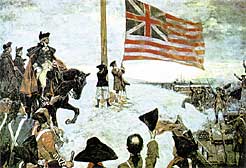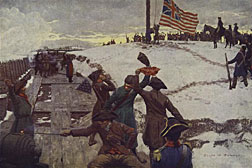
Part 2
On July 3, General George Washington arrived in Cambridge, newly appointed to take command of the Continental Army. He continued to build up all the fortifications along the seige line, putting the left wing division (including Prospect Hill) under the command of General Charles Lee. Soon, 4,000 men camped on Prospect Hill, despite British volleys and a smallpox outbreak.
Prospect Hill was also an early example of the use of war propaganda. Leaflets were distributed to British troops on Bunker Hill that compared their circumstances rather unfavorably to those enjoyed by the colonists.
A Declaration of the Continental Congress on the reasons for taking up arms was read aloud to Putnam's Division on Prospect Hill on July 18. The troops responded with three cheers and the firing of a cannon, as well as the raising of the Division's flag, bearing the motto "Appeal to Heaven with American Arms."
Not everything went smoothly for this young army. Washington worked hard to bring discipline to riflemen coming from all over the colonies. Because troops kept taking pointless potshots at the British, he issued an order against futile firing. When a sergeant was later arrested for it, quite a few men on the hill began rioting openly. Eventually 33 men were arrested and fined, and order was again restored.
January 1, 1776 is the date that made Prospect Hill famous. On this day, George Washington ordered that a new flag be raised on a 76-foot schooner mast placed on Prospect Hill. This "Grand Union Flag" was the first true American flag, representing the united colonies. It was raised with a salute of 13 guns and loud huzzahs by the soldiers.

Painting of flag raising (enlarge)

Another painting (enlarge)
The flag design wasn't sanctioned by the Continental Congress, but was a design that Washington and others liked. It combined the British crosses of St. Andrew and St. George with 13 red and white stripes, which may seem strange. It's important to note that at the time, most Americans were fighting for respect and representation, not for independence, so this sign of continued loyalty to the crown was appropriate.
That same day, a speech of King George's was being distributed in Boston. When Loyalists saw the somewhat familiar flag flying on Prospect Hill, they thought that the speech had convinced the colonists to surrender.
From a letter written by George Washington on January 4...
"We gave great joy to [the British] without knowing or intending it, for on that day which gave being to our new army, but before the proclamation came to hand, we hoisted the Union flag in compliment to the United Colonies. But behold! it was received at Boston as a token of the deep impression the speech had made upon us, and as a signal of submission. By this time, I presume, they begin to think it strange that we have not made a formal surrender of our lines."
The Grand Union Flag flying on Prospect Hill continued to be a great morale booster for troops in the seige of Boston, maintaining them until the British were finally driven out of the city in March of 1776. It remained the de facto national flag until the Continental Congress authorized the more familiar Stars and Stripes in June of 1777.
Near the end of the war, Prospect Hill was used as a POW camp for British troops. Starting in November 1777, over 2,300 British troops captured at Saratoga were kept here for a year.
